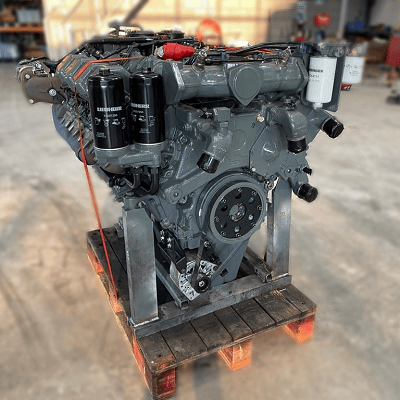The process of a dyno test on a Liebherr engine

When it comes to heavy machinery, reliability and power are paramount. Liebherr, a name synonymous with innovation and excellence in engineering, stands tall as a pioneer in the realm of heavy equipment and machinery. From towering cranes to robust excavators, Liebherr’s engineering prowess extends to the heart of these machines. We delve into the world of dyno testing a Liebherr engine, uncovering the meticulous process behind unleashing the raw power concealed within.
The foundation of excellence
Before we embark on the journey of dyno testing, it’s crucial to understand the foundation upon which Liebherr engines are built. With decades of engineering expertise and commitment to quality, Liebherr engines are crafted to withstand the most demanding environment and deliver unparalleled performance. Each component is meticulously designed and rigorously tested to ensure reliability, efficiency and longevity.
The process
1 Preparation: The engine undergoes meticulous preparation before being mounted onto the dynamo meter. This includes ensuring all connections are secure, fluids are filled to the appropriate levels, and sensors are properly calibrated.
2 Mounting: The engine is carefully mounted onto the dynamometer, a specialized device designed to simulate real-world operating conditions. Precision is paramount during this step to ensure accurate results.
3 Initial checks: Once mounted, a series of initial checks are conducted to verify proper alignment, connection integrity, and functionality of all engine systems.
4 Warm-up: The engine is started and allowed to warm up to operating temperature. This ensures consistent results and minimizes the risk of damage during testing.
5 Baseline testing: With the engine warmed up , baseline tests are conducted to establish initial performance metrics. This includes measuring power output, torque, fuel consumption, and emissions at various RPM levels.
6 Load testing: The engine is subjected to progressively increasing loads to simulate different operating conditions, such as idle, partial load and full load. This allows engineers to assess performance across the entire operating range and identify any potential issues or optimization.
7 Data analysis: Throughout the testing process, data is continuously collected and analyzed in real-time. Advanced instrumentation and software are used to monitor performance metrics and identify trends or anomalies.
8 Optimazation: Based on the data analysis, adjustments may be made to optimize engine performance. This could involve fine-tuning fuel injection timing, adjusting air-fuel ratios, or optimize turbocharger boost pressure.
9 Validation: Once testing is complete, the results are meticulously reviewed and validated against predetermined criteria and specifications. Any deviations or anomalies are thoroughly investigated to ensure accuracy and reliability.
10 Reporting: Finally, a comprehensive report is generated detailing the results of the dyno testing, including performance metrics, observations, and any recommendations for further optimization or refinement.
The outcome of dyno testing
Dyno testing a Liebherr engine is more than just a routine procedure – it’s a testament to the unwavering commitment to excellence that defines Liebherr’s engineering philosophy. By subjecting their engines to rigorous testing and analysis, Liebherr ensures that each engine delivers the uncompromising performance, reliability, and efficiency that customers expect.
In conclusion, dyno testing a Liebherr engine is not just about measuring power output. It’s about unlocking the true potential of these remarkable engines and ensuring they exceed expectations in the most challenging environments imaginable.
High speed Auto- Recovery zipper Door
Auto Recovery Rapid Door
Zippered Quick door Features
Open: 1.2-2.0m/Sec
High airtight energy efficient : Zipper patented technology and curtain rail technology combines high seal ability for maximum energy efficiency
Self-healing maintenance cost savings :When the door by the impact and dislocation occurs , repeat mosaic patented technology that is deralling repair system starts automatically , without any manual and automatic reset to its original state force to effectively reduce maintenance time saving cost
High security : Curtain soft and elastic , without any load at the bottom of the door to change , to ensure that the operator in an emergency state in the collision to the door when the operation will not cause harm
Push pull dual hinge system :unmatched safety record and absolute tightness in push pull twin shaft system, loading close dependence and the curtain at the bottom of the traditional fast door to achieve , you can drive dual axis system so that the upper curtain sprocket perfect bite does not depend on the door of its own weight can be achieved fast closing , this patented technology to avoid the hard parts usage of
More than one million times the durability performance : speed doors reduce the use of materials , easy to wear , strong and flexible curtain is very durable , can withstand million of opening and closing operation ,
in the use of some products has reached 500 million times for opening and closing
The soft curtain anti-collision fast door has simple structure design, which is beneficial to stable operation, reduces the frequency of repairing and replacing wearing parts, effectively improves the durability and service life of the equipment, and the curtain can be derailed in the event of an accidental impact, and during the ascent Automatic reset, no need to manually repair and reset the whole process.
Heating devices are included on both sides of the column.
The structural design of this product is characterized by trouble-free operation up to 150,000 times per year. It has the highest practicality and the lowest maintenance cost.
Auto Recovery Fast Door, AGV high speed auto door, AGV room high speed Door
SHENZHEN HONGFA AUTOMATIC DOOR CO., LTD , http://www.hongfarrd.com